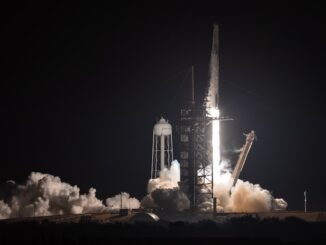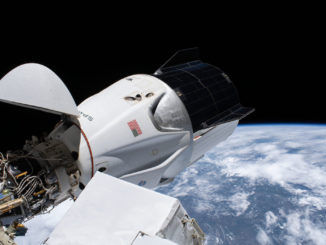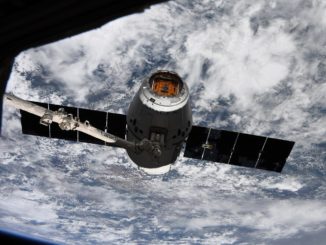
SpaceX may be on the cusp of launching its massive Starship rocket for a third time, potentially as early as next Thursday. In an online update, the company said it is targeting Thursday, March 14 for the third flight test of Starship “pending regulatory approval.”
While SpaceX didn’t publish a launch time on its website, a livestream post on X (formerly Twitter) showed a start time of 7:30 am EST (6:30 a.m. CST, 1230 UTC). Coupled with SpaceX stating that its broadcast would begin about 30 minutes prior to liftoff, that suggests a target launch time of 8:00 a.m. EST (7:00: a.m. CST, 1300 UTC).
The mission continues SpaceX’s iterative approach to developing its Starship rocket, which involves flying as much as possible and getting through as much of its mission profile as it can. SpaceX is hoping to push a number of boundaries for the vehicle with this flight.
On the Ship 28 upper stage for instance, SpaceX aims to test the payload door, conduct a re-ignition of one or more Raptor engines while in space and conduct a propellant transfer demonstration during the coast phase.
Being able to demonstrate propellant transfer in space is key not only to SpaceX’s future ambitions, but also to NASA’s Artemis program. While this flight will perform the transfer within Ship 28, the next big leap will be a ship-to-ship transfer.
SpaceX will need to launch several Starships in order to fuel a tanker on orbit. That tanker will then be used to shift that propellant to the Human Landing System program’s version of Starship, which will carry astronauts down to the surface of the Moon and back up again.
In February, NASA and SpaceX were busily testing docking mechanisms that will allow its Orion spacecraft to dock with the HLS Starship while in lunar orbit. They performed the work at NASA’s Marshall Spaceflight Center, the NASA installation where the HLS program is based.

While this third flight test won’t include a payload, SpaceX needs to reach orbit to achieve its stated goals. During a company talk given earlier this year at Starbase in southern Texas, SpaceX founder Elon Musk explained why they believe Starship failed to reach orbit during its second flight test.
“Flight 2 almost actually made it to orbit. In fact, ironically, if had had a payload it would’ve made it to orbit,” said SpaceX founder Elon Musk during a company talk earlier this year. “The reason that it didn’t quite make it to orbit was because we vented the liquid oxygen and the liquid oxygen ultimately led to fire and an explosion.”
“We wanted to vent the liquid oxygen because we normally wouldn’t have that liquid oxygen if we had a payload. So ironically, if it had a payload, it would’ve reached orbit. And so, I think we’ve got a really good shot of reaching orbit with Flight 3,” he added.
SpaceX noted in its launch announcement that Starship will launch on a new flight path that will see it target a splashdown in the Indian Ocean roughly an hour after liftoff.
“This new flight path enables us to attempt new techniques like in-space engine burns while maximizing public safety,” SpaceX said in a statement.

Lessons learned
Prior to Wednesday’s announcement of Starship’s next launch date, SpaceX published a blog post, offering some insight into what it learned about the second flight test of Starship. It pointed to one of the 33 Raptor engines on the Super Heavy booster that “failed energetically” during the 13-engine boostback burn, which caused the vehicle to explode roughly 3.5 minutes into flight.
“The most likely root cause for the booster [rapid unscheduled disassembly] was determined to be filter blockage where liquid oxygen is supplied to the engines, leading to a loss of inlet pressure in engine oxidizer turbo pumps that eventually resulted in one engine failing in a way that resulted in the loss of the vehicle,” SpaceX stated. “SpaceX has since implemented hardware changes inside future booster oxidizer tanks to improve propellant filtration capabilities and refined operations to increase reliability.”

Addressing this was part of the 17 action items established through the SpaceX-led mishap investigation following OFT-2. On Feb. 26, the same day SpaceX published its blog post, the Federal Aviation Administration (FAA) notified the public that it closed the mishap investigation.
It outlined seven corrective actions needed for the Super Heavy Booster and ten for the Starship upper stage. As part of those actions, SpaceX noted that it would introduce “new electronic Thrust Vector Control system for Starship’s upper stage Raptor engines and [improve] the speed of propellant loading operations prior to launch.”
Before Starship can fly for a third time, SpaceX will need to receive a license modification from the FAA. For a timescale comparison, ahead of the second flight test of Starship, the FAA announced the completion of the safety review portion of the launch license evaluation on Oct. 31, 2023, and the U.S. Fish and Wildlife Service wrapped up its formal consultation on Nov. 14. That paved the way for a launch license to be issued from the FAA to SpaceX on Nov. 15.
Following a wet dress rehearsal tanking test on Oct. 24, SpaceX posted a similar update to social media as its most recent one from Wednesday morning. It stated that Starship was ready for its second test flight “pending regulatory approval.”
Vehicle is ready for the second test flight of a fully integrated Starship, pending regulatory approval pic.twitter.com/9tC4yKecmw
— SpaceX (@SpaceX) October 25, 2023
That was followed by another post on X on Nov. 3 stating their hopes of launching “as soon as mid-November, pending regulatory approval.” SpaceX’s next post to X regarding Starship came on Nov. 10, stating “Starship preparing to launch as early as November 17, pending final regulatory approval.”
SpaceX confirmed the intended launch date of Nov. 17 once the launch license was formally approved on Nov. 15. The launch itself pivoted to Nov. 18 due to an issue that came up with a grid fin actuator on the Super Heavy Booster.
Given that this is the third flight test of Starship and not nearly as much needed to change between flights two and three as did between one and two, the declaration of a March 14 launch date without having a launch license firmly in hand may prove to be true.
However, final regulatory approval is still being determined by the FAA. A spokesperson told Spaceflight Now on Wednesday that they didn’t have an update to provide on the progression towards issuing this third flight license.
So for now, it and the launch remain pending.
This third Starship launch would significantly break our record for the gap between second and third flights of a new launch vehicle, which had greater than a year gap for both Falcon 1 and Falcon 9. Let’s go! https://t.co/o57Mbp80dp
— Trip Harriss (@SpaceXTrip) March 6, 2024



